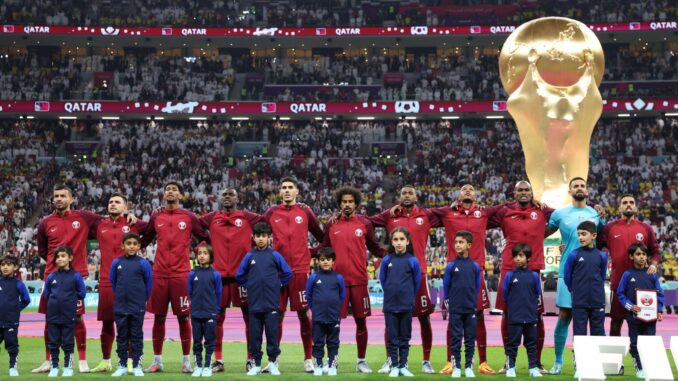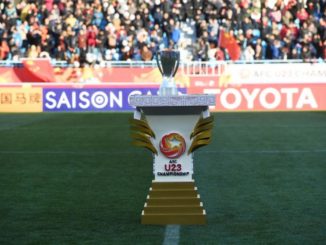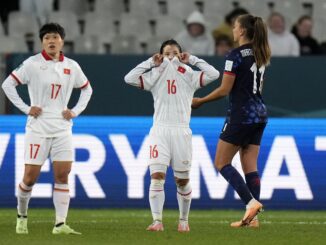

The Asian Game’s coverage of the FIFA World Cup Qatar 2022 is proudly sponsored by SMC.
Twelve years in the making, it took Qatar only five days to exit their first World Cup, becoming statistically the worst performing hosts in the tournament’s history. So, where did it all go wrong?
In what ended up becoming Asia’s most successful World Cup, with three nations making it through to the Round of 16, the Maroon were left sidelined as the laughing stock of a continent they conquered a mere three years ago.
The immediate reaction to Qatar’s early exit has swayed between pity and disappointment, from derision to embarrassment. We’ve seen underdog hosts enter at this stage with little-to-no hope before, but while the likes of South Korea in 2002, South Africa in 2010 and Russia in 2018 rose to exceed their expectations, Qatar shrunk in the spotlight.
Given the billions of dollars invested, not only in the organisation of the World Cup but in developing grassroots football from the bottom up, the inquest into such a spectacular on-field failure will start in earnest shortly after Sunday’s World Cup final has concluded.
The questions for now remain: how could a team sink from the top of Asia to heading home after only two matchdays, in the space of three years? And what will the reaction look like in the build-up to another host tournament, as they prepare to defend their Asian Cup title in just a year’s time.
“Preparation is the key to success”
Much of the discussion leading up to the World Cup surrounded Qatar’s illusive preparations. Bedded down, away from the spotlight, away from scrutiny, Felix Sanchez’s side spent six months out of the Doha goldfish bowl in two lengthy training camps away in Europe, in both Austria and Spain.
In a direct replication of how South Korea approached their hosting of the World Cup in 2002, the aim was simple: create a unified, controlled environment that would generate a greater harmony than that of their World Cup opposition, who were being granted just days in camp between club commitments and joining up with their teammates in Qatar.
Embed from Getty ImagesWhile the Korean episode resulted in continental history being made, with the Taegeuk Warriors making it through to the last four – still Asia’s most accomplished feat at a World Cup – Qatar’s approach went in the complete opposite direction.
Stale, stagnant and uncompetitive, the environment created during that half a year away from regular domestic play looked a mistake from the first minute they stepped onto the pitch over the summer; demonstrated in drab results and insipid performances against low calibre, uncompetitive opposition.
A clear mistake, then?
While the results alone suggested that the final lead up was primarily at fault, the training camp did have some benefits.
Qatar’s squad heading into this period was select to say the least. While results at the World Cup were bad, the fact they could at least call on their best squad, without injury or fitness concerns, ponders the question as to whether it could’ve actually been a lot worse if Sanchez became bereaved of options.
And even if the players had been able to return to their club sides in the autumn, there’s a growing debate as to whether the Qatar Stars League, a domestic standard which has consistently dropped off the pace over the last few years, could adequately replicate the standard required to prepare for the World Cup.
The sole focus on this camp is probably overstated, with much of the damage having been done across the previous three year period as a whole.
Following their Asian Cup triumph in 2019, Qatar chose to stand still, rather than use their success as a platform to move forward. Sanchez retreated in his methods, following unanimous backing from the QFA.
With earned trust, instead of experimenting without being under a cloud of scrutiny, he instead committed implicitly to his regulars, shirking wherever possible the alternatives in favour of his core group.
Embed from Getty ImagesOf the 14 players that played 90+ minutes at the World Cup, only three didn’t feature in the Asian Cup winning squad a whole cycle ago; one, Meshaal Barsham, may have not even seen pitch time at all but for an opening day calamity from Sanchez’s regular number one Saad Al-Sheeb.
The failure to support players in seeking moves to Europe over the last two years has also hampered their development severely.
The likes of Almoez Ali, Akram Afif and Abdelkarim Hassan have all spoken out on their willingness to test themselves outside of Qatar, but while offers came their way following their triumphant Asian Cup campaign, the QFA, in search of total control over World Cup preparations, put a halt on any moves until after the tournament had passed.
It’s not a surprise, therefore, that in both the QFA and Sanchez, their search for control limited Qatar’s options and development once the World Cup started.
Heading into the last few years of preparation, no one could have suggested disharmony or a lack of cohesion within this squad; which makes it frustrating how much this was prioritised over that period, rather than seeking out exposure or alternative options from outside the preferred squad.
Tactical approach comes unstuck at the very highest level
It was once the tournament started, however, where the problems multiplied. The flawed optimism, that Qatar would put to bed any ineffectiveness demonstrated in uncompetitive play, once they returned to the competitive arena, as they did at the Copa America and Gold Cup in the lead-up, was quickly extinguished, and rarely made even a glimmer of an appearance at the World Cup.
While their capitulation in the opener against Ecuador could have been put down to nerves and the significant expectation surrounding the match, subsequent efforts against Senegal and Netherlands, where admittedly the team looked calmer and less restricted, similarly illustrated little of what Sanchez had instilled in the team over the last five years.
In many ways, Qatar were caught between two approaches they’ve often toyed with over Sanchez’s tenure.
Embed from Getty ImagesOne being their more successful, hallmarked approach that clinched continental silverware. Attack focused, quick and direct; a system that worked effectively against weaker opposition and crucially when the team hummed with confidence.
The other, a more stereotypically underdog set up, which has been readily seen across the World Cup, especially from their Asian peers, to sit back, congest space and look to counter against stronger opposition.
Across the three games, however, neither approach seemed to be fully embraced, leaving Qatar open, more often than not to an effective sucker punch.
The pressing tactics once seen in unison from this Qatar team, were distinctly infrequent.
Almoez Ali, with so much praise heading into the tournament, struck a broadly static figure at the point of the attack. Captain Hassan Al-Haydos demonstrated that he clearly hasn’t got the legs to consistently defend high over the course of a match nowadays. All of which left the physical and technical, but highly immobile, Karim Boudiaf often isolated centrally; a key aspect that led to both of Ecuador’s goals in the opener.
Qatar’s philosophy under Sanchez has always embraced technicality over physicality, so sitting deep also brought with it its difficulties. The stature and aerial capability of his back three – Bassam Al-Rawi (or Pedro for the subsequent matches), Boualem Khoukhi and Abdelkarim Hassan – had been questioned for months heading into the World Cup; it was no wonder that this once again was their Achilles heel.
The worldwide media, predictably unaware of Qatar’s strengths and undoubted weaknesses, often tried to compare Qatar to other underdog tales of years gone by; typical hard workers and those that make up ground through set-plays, but in truth this team hasn’t the individual skillset to thrive in these moments.
If anything, Qatar’s failings were that they tried (but failed) to play football, and merely came up against teams that mirrored their style, just at a much, much higher quality and level of effectiveness.
Embed from Getty ImagesIt comes as less of a surprise to note that the better players in the Qatari squad at the World Cup were less in the Sanchez mould and more of the physicality that could potentially seek out weakness in their superior opposition’s defences.
The sheer determination and speed of Ismaeel Mohammed on the right flank, and the towering, direct presence of Mohammed Muntari in attack, in the end created many of the best attacking forays for Qatar across the three matches, combining for the team’s only goal of the tournament against Senegal.
It’s interesting to highlight, as neither really made it into Sanchez’s plans over the last few years given his preference for technical ability, and also look likely to be phased out in the upcoming cycle.
Heading into 2022, the ambition, if anything was that their individual players would have an opportunity to showcase themselves on the grandest stage, in the hope of a move away to Europe, or elsewhere in Asia would greet them.
While many fluffed their opportunity, Akram Afif, the side’s talisman, did demonstrate some of the qualities that saw him crowned AFC Player of the Year in 2019, but all of that felt too brief and cameo-like to truly be effective. It was clear he was Qatar’s most technically gifted player, that’s for sure, but for his own or his teammates fault, that didn’t ever correspond with a telling end product.
Legacy of 2022
So, following the eye-watering sums of money invested, and the long lead in time for each of these players careers, what is the lasting legacy for Qatari football and the individuals involved?
Will growth be persisted with, and if so, in what guise? Persistence with Spanish ideals that have brought success in the past are starting to look a tad dated, so is a reassessment of their footballing philosophy and structures on the table, a tempting option given the successes of neighbouring Saudi Arabia over the last month.
What needs to be considered first, is playing staff. The question of who is going to lead this squad through the next World Cup cycle, and imminently at the next Asian Cup, which will again bring with it hosting pressures, not to mention the unenviable tag of defending champions.
Sanchez’s World Cup squad did include three players under 21. Somewhat a promising statistic, but none of them featured in the tournament, and remained significant outsiders under Sanchez’s watching brief, even in the latter days of preparation.
Embed from Getty ImagesThe likes of Homam Ahmed, Meshaal Barsham and Mohammed Waad, who did feature in the World Cup, the supposed next generation to prop up this World Cup group of players, have similarly stagnated since their prominent arrivals with the national team.
The days of back-to-back semi-final appearances at the U23 Asian Cup (in 2016 and 2018), have long since faded from memory, with not a single victory in their last two campaigns, while the next generation of talent that made the last four at the 2018 U19 Championships, including the likes of Abdulrasheed Umaru and Hasham Ali have largely been ineffective at club level, let alone in catching the eye of Sanchez.
The coming 12 months will be critical in determining which direction Qatar move forward. The federation’s ambition to conquer the world continues, now more on a charm offensive than with any concerted ambitions of competing for silverware; signing up for a second successive Gold Cup in June, before World Cup qualification kicks back into gear the following November.
Before you know it, and we’re twelve months down the line, with the delayed Asian Cup at the start of 2024. It’s a tournament that could potentially be billed as one of two prospects: either Sanchez’s last pitch at success with this current cohort or a new look Qatar starting their journey on the road to 2026.
An immediate milestone of concern, however, arrives early in the new year with the Arabian Gulf Cup taking place in Iraq. For what was supposed to be a significantly low-key affair for Qatar, following their World Cup excursions, has suddenly become an early opportunity to make a rapid response to their abject failure (as they did famously back in 2014).
It was entirely expected for Sanchez to sit this tournament out given its proximity to the World Cup, with U23 boss Bruno Pinheiro stepping in for January’s tournament. However, few would’ve predicted the significant senior inclusion within the squad, eleven of which featured at the World Cup, including the likes of Mohammed Muntari, Assim Madibo, Mohammed Waad and Meshaal Barsham.
A gloomy World Cup cloud will be hanging over the squad for some time, so an opportunity to write some of 2022’s wrongs has presented itself earlier than many would have suspected. What that means for Sanchez, already in very much a tenuous position heading into 2023, is very much an uncertain question.
With the Road to Qatar having only concluded a month ago for the Maroon, we are set to stride out on a new path, along the Road to USA/Canada/Mexico in the coming weeks. While a refresh is undoubtedly heading their way, what the Qatar national team will resemble, and who will lead them on that journey moving forward remains significantly up for debate.
Photo: twitter/QFA_EN
Listen to The Asian Game’s ‘Doha Daily‘ live from Qatar 2022




